Abstract
Hitherto, models of family economics focus on explaining theorganization of monogamous and polygynous family patterns. A thirdexisting marriage pattern, polyandrous marriages, has beenneglected. This paper shows that – in contrast to the common view – a polyandrous marriage may be individually rational. I considera game theoretic model of a subsistence economy whose membersmaximize their personal reproductive success. In this model, allthree family formations can appear as equilibrium solutions.
Similar content being viewed by others
References
Becker, G.S. (1973). A theory of marriage: Part I. Journal of Political Economy 81: 813–846.
Becker, G.S. (1976). Altruism, egoism, and genetic fitness: Economics and sociobiology. Journal of Economic Literature 14: 817–826.
Becker, G.S. (1991). A treatise on the family (enlarged edition). Cambridge, MA: Harvard University Press.
Berghe, P. van den, and Barash, D.P. (1977). Inclusive fitness and human family structure. American Anthropologist 79: 809–823.
Bergstrom, T. (1994). On the economics of polygyny (working paper). University of Michigan, Department of Economics.
Borgerhoff Mulder, M. (1988). Kipsigis bridewealth payments. In: Betzig, L., Borgerhoff Mulder, M. and Turke, P. (Eds.), Human reproductive behavior in a Darwinian perspective, pp. 65–82. Cambridge University Press.
Boserup, E. (1965). The conditions of agricultural growth: The economics of agrarian change under population pressure. Chicago: Aldine.
Crook, J. and Crook, S. (1988). Tibetan polyandry: Problems of adaptation and fitness. In Betzig, L., Borgerhoff Mulder, M. and Turke, P. (Eds.), Human reproductive behavior in a Darwinian perspective, pp. 97–114. Cambridge University Press.
Darity Jr., W.A. (1980). The Boserup theory of agricultural growth. Journal of Development Economics 7: 137–157.
Darwin, C. (1871). The descent of man and selection in relation to sex. London: Murray.
Edlund, L. (1996). Dear son - expensive daughter: Why do scarce women pay to marry? In: The marriage market: How do you compare? Ph.D. Thesis, Stockholm School of Economics.
Edlund, L. and Korn, E. (1998). A theory of prostitution. Dortmund University Discussion Paper 98-21.
Goldstein, M. (1974). Tibetan speaking agro-pastoralists of Limi: A cultural ecological overview of high altitude adaptation in the Northwest Himalaya. Objets et Mondes 14: 259–268.
Goldstein, M. (1976). Fraternal polyandry and fertility in a high Himalayan valley in Northwest Nepal. Human Ecology 4(3).
Goody, J. (1973). Bridewealth and dowry in Africa and Eurasia. In Goody, J. and Tambiah, S. (Eds.), Bridewealth and dowry. Cambridge: Cambridge University Press.
Grossbard-Shechtman, S. (1993). On the economics of marriage. Westview Press.
Hiatt, L.R. (1980). Polyandry in Sri Lanka: A test case for parental investment theory. Man 15: 583–602.
Jacoby, H.G. (1995). The economics of polygyny in Sub-Saharan Africa: Female productivity and the demand for wives in Cote d'Ivoire. Journal of Political Economy 103: 938–971.
Kuper, A. (1982). Wives for cattle. London: Routledge, Kegan &; Paul.
Murdock, G.P. (1967). Ethnographic atlas. University of Pittsburgh Press.
Orians, G.H. (1969). On the evolution of mating systems in birds and mammals. The American Naturalist 103: 589–603.
Paige, K.E., and Paige, J.M. (1981). The politics of reproductive ritual. University of California Press.
Peter, Prince of Greece and Denmark (1963). A study of polyandry. The Hague: Mouton.
Trivers, R. (1985). Social evolution. Menlo Park, CA: Benjamin/Cummings.
Author information
Authors and Affiliations
Rights and permissions
About this article
Cite this article
Korn, E. On the Formation of Family Structures. Public Choice 105, 357–372 (2000). https://doi.org/10.1023/A:1005198714654
Issue Date:
DOI: https://doi.org/10.1023/A:1005198714654




